Secret Wars for Dummies: Everything You Need to Know About This Summer’s Biggest Comic Event
Comics Features Secret WarsTo say that the history of Secret Wars has a lot of moving parts is a vast understatement: Marvel’s mammoth summer event is a Russian Nesting Doll of moving parts, if Russian Nesting Dolls could time travel and break into the fourth dimension. Writer Jonathan Hickman and artist Esad Ribic’s eight-issue miniseries—set to conclude the Marvel Universe as we know it—lies on a foundation of 77 issues of comics Hickman’s been writing since 2012 in Avengers and New Avengers. These two series have featured scores of orbiting characters, emerging and receding in alternating story arc cycles to solve meticulous mysteries seeded years in advance.
That said, the Secret Wars miniseries, whose first issue debuts today, certainly won’t be impenetrable to those unfamiliar with the twists and turns that preceded it. Comics of this magnitude cater to the curious as much as the converted, and the authors have crafted this event with newcomers in mind. “Secret Wars was designed to be fairly straight-forward,” explains Tom Brevoort, Executive Editor and Senior Vice President of Publishing at Marvel. “If you start with Secret Wars #1 then go into Secret Wars #2, the basic structure of who the players are, where they are on the board and what they are struggling for will be laid out directly and simply.”
Most of the mysteries posed were solved in last week’s Avengers #44 and New Avengers #33. That said, if you’re curious about the building blocks of this event, want to understand what exactly this event will mean for the most popular editorial line in comics and want to learn about one of the coolest, most involved superhero story arcs in recent memory, we’re here to support you. Brevoort, whose maintained a borderline-omniscient knowledge on all things Marvel for decades, generously offers his insight and expertise on the characters and developments. ![]()
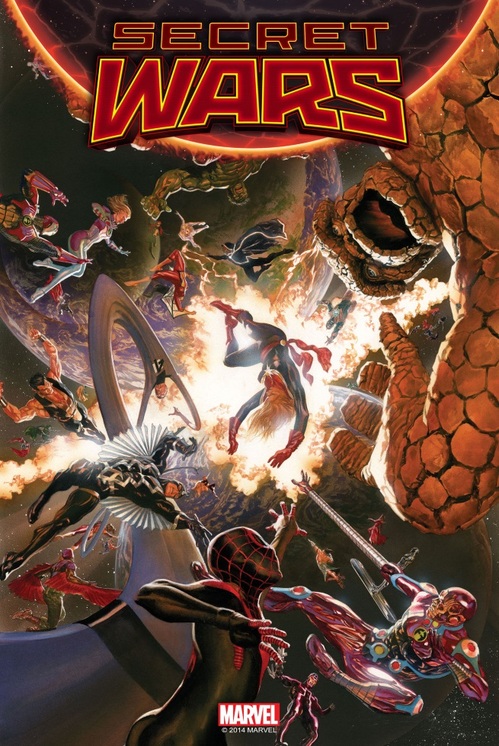
Secret Wars #1 Art by Alex Ross
Secret Wars: The Simple Hook
Even if you’ve only watched a Marvel movie like Avengers: Age of Ultron without reading a comic, Secret Wars offers a simple, enticing hook: the world is ending for an entire world of beloved superheroes. Done. The universe where such iconic characters including The X-Men, The Avengers, Spider-Man, Fantastic Four and The Inhumans fly, fight and love has reached a violent extinction point.
“It’s a relatively simple concept, even to a layman: the Marvel Universe is coming to an end,” Brevoort says. “Everything that we’ve published, every story that any Marvel character has been in—it’s all crashing to a head. Marvel heroes are working frantically to prevent the destruction of everything as Secret Wars opens, and they fail. This is the biggest event we’ve done in terms of its scale. Whether you know and love [the Marvel Universe] from having seen one film, or read comics when you were a kid, or having seen some of the animation, you can understand that it’s the end times and the Marvel heroes are striving to prevent it…but they don’t.”
That failure to prevent the cosmic apocalypse occurs in the pages of Secret Wars #1, but before we address exactly why the Marvel Universe falls into the end times—and who’s responsible—we’re going to look at how this sprawling event influences the other 70 comics that Marvel publishes monthly. ![]()
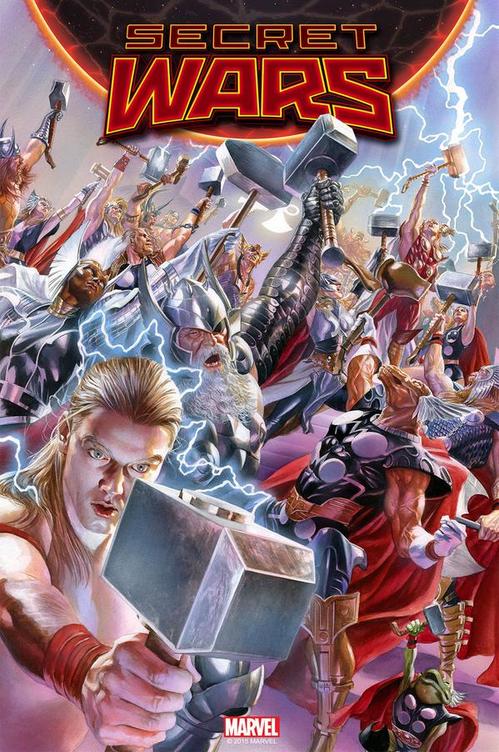
Secret Wars #2 Art by Alex Ross
How Does Secret Wars Affect Other Marvel Comics?
As Secret Wars closes the door on 54 years of publishing history (not counting the time when the company was known as Atlas or Timely), all current series will be involved in the event in some way—some more heavily than other. The only exceptions to this development are Marvel’s licensed books: Star Wars comics, Max Ride, the Stephen King Universe and comics based on Marvel Animation will not partake in Secret Wars. So with the universe ending, does that mean every current comic book will be ending as well? Yes, but don’t use the word “cancel.”
“Canceled implies they sold poorly and we’re ending them,” Brevoort clarifies. “They’re reaching their 616 conclusion, which is to say that the Marvel Universe’s fan designation was 616, because there was a story once that designated it as such. That doesn’t mean that Captain America isn’t selling; it means that Captain America’s 616 adventures are ending here. And then, eventually, as we get into Secret Wars, the new Marvel Universe Captain America book will launch. Who will be Captain America, and what will be the circumstances of Captain America? That is all to come.” So if you do like some of the comics coming out that have been slated for their “616” cancellation, keep in mind they’ll most likely re-emerge after this event concludes, albeit with a potentially different creative team.
This even applies to more character-driven series that might not interact as much with other comics or company-wide crossovers, such as Unbeatable Squirrel Girl. But each comic will be ending gradually in its own time. “We’re not stopping everything quite on a dime. Having a rolling handoff between the old Marvel Universe and the new Marvel Universe is how we are proceeding with this. Even books like Unbeatable Squirrel Girl and Punisher will get to their 616 conclusion, and then some iteration of them—or some book like them—will emerge on the other side as part of the new Marvel Universe,” Brevoort says.
Click to discover how the Marvel Universe is ending, how Doctor Doom Started his own religion and to learn the secrets of Battleworld.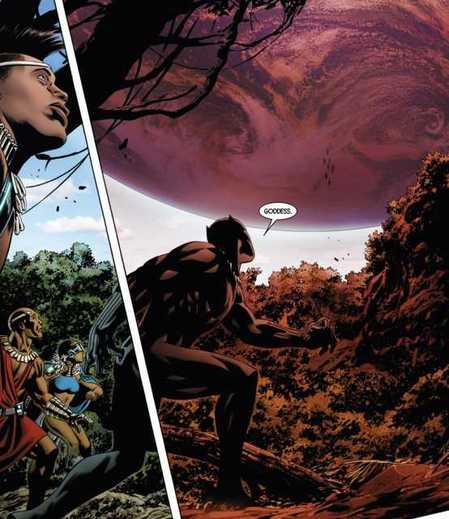
New Avengers Art by Mike Epting
How Exactly Is the Marvel Universe Ending?
As previously mentioned, the answer to this deceptively complex question can be found in Jonathan Hickman’s aforementioned runs on Avengers and New Avengers. In the pages of New Avengers #1, an elite group of Marvel’s heroes called The Illuminati discover a phenomenon in which universes are colliding with one another, destroying each other in the process. This cataclysm is called an Incursion. The Illuminati—comprised initially of the characters Black Bolt, Namor, Reed Richards (Mr. Fantastic), Iron Man, Captain America, Doctor Strange and Black Panther—seek to prevent encroaching universes from colliding with their reality, finding that the only way to spare their world is by removing the other, usually by violent means. “Incursions occur when two universes collide; only one can survive this event if the other is destroyed before the point of impact. The intersection of the two universes is at the point of the earth,” Brevoort says. “If you think of it as taking two pieces of paper and putting them together, the touch point there is always the earth. Once the parallel world and our earth would contact, both universes would be annihilated. But if one of the earths was removed, that would not happen.”
The Illuminati use various means to destroy invading earths, raising ethical questions about what it means to be a hero if heroes destroy an entire universe to preserve their own. (In one resonant plot line, the Illuminati force Captain America to forget their worlds-destroying agenda with a magic spell after Cap objects.) The Illuminati use a rare artifact called The Infinity Gauntlet, weapons technology from Tony Stark, powers acquired by Doctor Strange after he sells his soul and other ethically questionable solutions to repel these incursions. Meanwhile, a group of villains called The Cabal—eventually consisting of a defecting Namor, Thanos, Black Swan, Terrax, Proxima Midnight, Maximus and Corvus Glaive—embark on their own planetary culling, physically assaulting and destroying planets.
Eventually, all but two universes in the Marvel multiverse face each other within the pages of Secret Wars #1. Read on to discover how this happens. ![]()
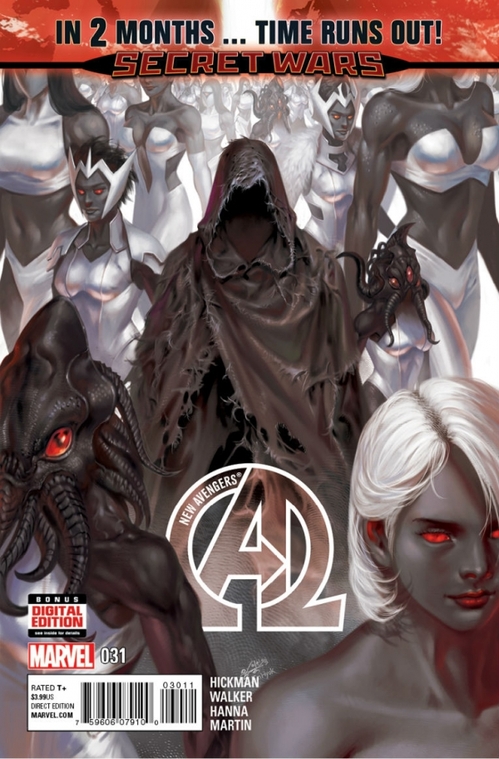
New Avengers Art by In-Hyuk Lee
But Why Are Universes Colliding?
The answer to the incursions lies behind a minor Fantastic Four villain named Owen Reece, or Molecule Man. In many ways, the events leading to Secret Wars revolve around Reece, though he receives marginal action within the comics involved. In New Avengers #33, Hickman reveals that a group of near-omnipotent cosmic beings called The Beyonders (more on them in a bit) have weaponized the character to simultaneously end life on all known universes.
Brevoort goes into more depth on the character’s manipulation and linchpin status: “Molecule Man’s ability is to manipulate and control the molecular subject of pretty much anything. As we discover in New Avengers #33, the source of that power, the thing he taps into and the thing that makes him unique, is the higher realm, the outer space of The Beyonders, And in doing so, Owen Reece is a multiversal constant. In all the various parallel worlds, there may be different Tony Starks. There may be different Steve Rogers. There will be different guys who are Iron Man or Captain America, or whomever. But there is always an Owen Reese and there is always a Molecule Man, and effectively they are all one being that exists across the multiverse simultaneously. So he is a thread that joins everything. His creation was essentially The Beyonders setting up their fireworks to detonate all of the Molecule Men at once, and blow everything up to see what the results would be.”
Yet, The Beyonder’s agenda to ignite one superhuman and end all creation fails. Molecule Man informs fellow Fantastic Four antagonist Doctor Doom of The Beyonders’ scheme. Doom creates an alias—Rabum Alal—and cultivates a religion followed by a group called the Black Swans—beautiful, pale women who may be different multiversal variants of the same character. Doom then goes about destroying versions of Molecule Man scattered across the multiverse, becoming a “serial killer who only kills one person.” Likewise, Doctor Strange assumes control of an occult group called The Black Priests, who destroy worlds by speaking arcane words. “Doom and Doctor Strange have spent many years in the background traveling from world to world destroying and dispatching the Molecule Men of those universes prematurely. They’re basically cutting the fuse so it cannot be so long and have quite the same detonative power that it would otherwise,” Brevoort says.
It’s only when The Beyonders realize that external forces are meddling with their plan that they start the incursions, hurdling universes into one another. They even release a virus that turns any robotic entity traversing the multiverse into a Mapmaker, a scout designed to report any of the forces murdering Molecule Men and hindering the plan for the instantaneous death of creation. ![]()
The Beyonders: The Enemy of Reality
If The Beyonders’ name sounds familiar, this isn’t the first time this group of cosmic baddies has posed a threat to The Marvel Universe. A juvenile Beyonder forced Marvel’s villains and heroes to fight one another in a previous Secret Wars series from Jim Shooter, Mike Zeck and Bob Layton that ran from 1984 to 1985. That same Beyonder would incite similar trouble the next year, taking on a more human guise with a decidedly disco fashion sense. In Secret Wars 2015, this mysterious sect proves far more menacing, taking on the appearance of threatening mechs.
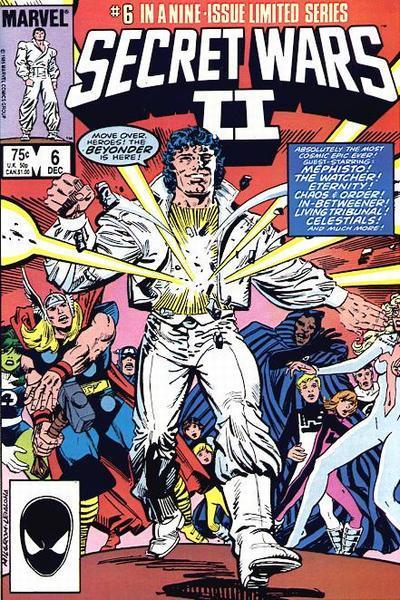
Secret Wars II art by Al Milgrom
“I think it’s safe to say that [The Beyonders] are unknowable, seemingly omnipotent beings from outside the confines of the normal universe,” Brevoort says. “They also resemble things out of Cthulhu mythology: Big, scary, dark ancient creatures who have been there since before our universe existed, who are unknowable and unfathomable. They have designs on our 3-dimensional, physical existence. Their true form is unknowable because they are outside of our existence; to interact with the human world, they need to take on tangible form, the same way the original Beyonder took on the form of Captain America and then a dude with Jheri curls. We’ve seen them manifest as robots, we’ve seen them manifest as these half-there, half-not-there fourth dimensional creatures. All of that is them projecting themselves into this 3-dimensional or 4-dimensional physical space. So it’s not necessarily their true forms—I don’t necessarily think you can see or know their true forms. They are beyond us.”
The Ultimate Universe Vs. The 616
Before the beginning of Secret Wars #1, Doctor Doom challenges The Beyonders to a face-off. In the ensuing confrontation, every universe inexplicably disappears except two: The Ultimate Universe and the 616, or the main Marvel Universe. Both universes lie on a collision course with each other, and both sets of heroes scramble for a solution. For those unfamiliar, Marvel created The Ultimate Universe in 2000 as a brand new editorial line to invite new readers to its characters without the burden of convoluted history.
Brevoort describes the Ultimate Universe as Marvel’s former endeavor to reintroduce its most enduring properties in a more modern context, or what was modern a decade and a half ago when the line launched. “It’s the origin of Spider-Man, but it’s happening now (then in the year 2000) as opposed to 1962, and so Peter Parker was effectively a kid from the year 2000, rather than a 20th century kid in 1962. He lived in a modern world with laptops and iPods and cellphones, in a way that the Spider-Man of 1962 lived in what was then a modern world. It’s the same essential idea of the character, but given a more modernistic twist. And now after 15 years, that universe has built up enough history and backstory and baggage, that it is just as complicated as the universe that it was there to provide a streamlined alternative to.”
The Ultimate Fantastic Four, for example, gained its powers through cross-dimension teleportation as opposed to space exploration. In the ensuing narrative, Reed Richards takes a villainous turn, creating his own evolved world, destroying Europe and adopting the name The Maker. This character plays an especially large role in Secret Wars, establishing his own plans against The Marvel 616 Universe hours away from its collision. ![]()

Things to Come: Last Days, Battleworld and Warzones
Though Brevoort is tightlipped about what the remaining Marvel Universe will look like after the denizens of the 616 and Ultimate Universes fail to save their respective worlds, Marvel has released a set of three labels describing the stories occurring alongside Secret Wars: Last Days, Battleworld and Warzones. Last Days looks to follow individual characters navigating the change introduced by Secret Wars, including solo acts like Captain America, Punisher and Black Widow.
Battleworld and Warzones play into a bigger mystery that’s yet to be fully explained: Secret Wars will host a number of series paying homage to previous Marvel events and parallel universes, all geographically represented in a patch-work new world. “Within the context of Secret Wars, we are revisiting a number of key and crucial Marvel events from years past. Marvel stories that made a big impact and were all events within themselves: Secret Wars is effectively the event that contains events.”
Memorable, world-altering events such as Old Man Logan, Civil War, House of M, Inferno and Years of Future Past (swapping out Days as it’s been years time since the X-Men game changer) all receive their own nation state or miniseries in the course of Secret Wars. In many cases, a different creative team will take over the new miniseries from the original creators, such as Brian Bendis and Andrea Sorrentino taking over new Old Man Logan stories—a geriatric Wolverine fighting characters in a world where the villains conquer—from Mark Millar and Steve McNiven (though the latter still illustrates covers). Those stories and those series will all contribute, in their way, different pieces to what comes out the other side. ![]()
While there’s quite a bit of plot of development that led to Secret Wars, this miniseries is in fact simplifying a huge ecosystem of characters and events, while celebrating that expansive history in the process of streamlining it. We definitely hope this information helps clarify how Secret Wars came to be and how it impacts The Marvel Universe. Secret Wars #1 by Jonathan Hickman and Esad Ribic goes on sale today. Special thanks to Tom Brevoort for all of his help.